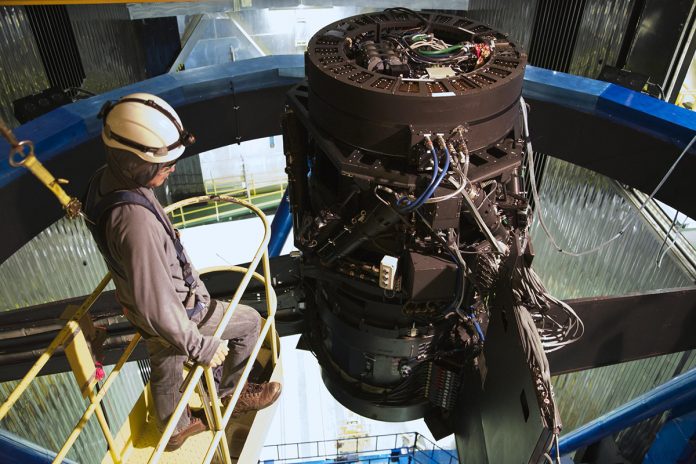Saku Tsuneta, National Astronomical Observatory of Japan, introduces the Subaru Telescope, Japan’s world-leading optical and infrared astronomy facility
The Subaru Telescope, an 8.2-meter diameter optical and infrared telescope located in Hawai`i, is the flagship facility of Japanese astronomy. Since 2000, an ever-evolving instrument suite keeps the Subaru Telescope on the cutting edge of science. It has been used by over 17,000 researchers to produce high-quality results including 156 PhD theses. In terms of citations, 16% of scientific papers using the Subaru Telescope rank in the top 10% of papers; and over 3% of Subaru Telescope papers rank in the top 1%.
The Subaru Telescope’s role
In the coming decades, results from extremely large telescopes will change the way we think about humanity’s relationship to the Universe. But as organisations around the world race to build larger telescopes, they face a trade-off. Larger telescopes have innately smaller fields of view, meaning the portion of the sky that can be captured in one observation. Simply put, extremely large telescopes will see an extremely small area extremely well. But without a comprehensive and accurate map of potential targets, these enormous telescopes will spend all their time staring at empty space, hoping for something interesting. Figuring out where to point a telescope to do the best research can be a difficult question.
The Subaru Telescope is and will continue to be the best telescope in the world for creating maps to guide future extremely large telescopes. Utilising a unique four foci design, the Subaru Telescope is able to side-step the size vs. field-of-view trade-off, achieving by far the largest field of view of any 8-metre class telescope. To make the best use of this advantage, we developed Hyper Suprime-Cam (HSC), one of the world’s largest digital cameras (shown in photo). HSC uses 870 megapixels to capture an area nine times the size of the full moon. This wide field of view is important to create cosmic maps.
The Subaru Telescope’s wide field of view and high sensitivity also provides an unparalleled advantage for quickly finding the optical counterpart of gravitational wave or neutrino burst events, which involve instantaneous releases of unimaginable amounts of energy. The progenitors of these events evolve quickly after the outburst, but they are difficult to locate exactly for further study. The Subaru Telescope can “cast a wide net” to find them before they change too much. This is the paradigm of the emerging field of multi-messenger astronomy: observations of the same event in electromagnetic waves, ranging from radio to gamma rays, are combined with observations of non-electro-magnetic messengers such as gravitational waves or neutrinos to build a comprehensive picture of the Universe.
Next-generation facilities and the Subaru Telescope
Soon, the Rubin Observatory Simonyi Survey Telescope will start observations with a field of view even wider than the Subaru Telescope. However, the Subaru Telescope will continue to offer observational capabilities not available at Rubin Observatory. Most notably, the Prime Focus Spectrograph (PFS) can simultaneously observe up to 2400 astronomical targets across a field of view comparable to that of HSC. PFS observes spectra allowing astronomers to determine crucial information about an object’s speed, distance, and chemical composition. Therefore, Rubin Observatory will be our synergetic collaborator.
In the coming decades, extremely large 30-metre class telescopes will revolutionise how we think about the Universe and humanity’s place in it. At the National Astronomical Observatory of Japan (NAOJ) we are participating in the TMT (the Thirty Meter Telescope) project, along with the California Institute of Technology, the University of California, the National Astronomical Observatories of the Chinese Academy of Sciences, the Department of Science and Technology of India, and the National Research Council (Canada). Larger telescopes can see fainter objects, more distant objects, and finer details. Therefore, TMT will be an ideal facility to follow up on interesting objects found by the Subaru Telescope.
Collaboration driven discovery
Twenty-first-century astronomy is founded on collaboration. There is collaboration across political boundaries to construct large-scale facilities like TMT. There is also a collaboration between research facilities and collaboration across the traditional boundaries between research fields.
The Universe is a marvellous science laboratory filled with naturally occurring phenomena that are impossible to reproduce on Earth. For example, we still have little direct observational data about dark matter and dark energy which dominate the Universe. To unlock the mysteries of the Universe, the Subaru Telescope is stimulating cross-disciplinary work combining astronomy, general relativity, life sciences, and informatics involving big data and Artificial Intelligence.
The Subaru Telescope as part of the community
The Subaru Telescope has long collaborated with neighbouring facilities in Hawai`i like W.M. Keck Observatory and Gemini North. Going forward, the Subaru Telescope will engage in synergetic collaboration with diverse partners such as Rubin Observatory, TMT, and multi-messenger facilities. Looking to the space-based astronomy community, the Subaru Telescope has initiated collaboration with NASA’s Nancy Grace Roman Space Telescope and ESA’s Euclid space telescope.
These collaborations on the ground and with space go beyond simple coordinated observations and data exchange. It starts much earlier, in the planning stages, deciding what instruments to build, what programs to conduct, and setting the overall direction for world astronomy in the coming decades.
It is fitting that the Subaru Telescope, which is charting the course for us to explore the heavens, is located in Hawai`i, where Native Hawaiians have long practised wayfinding, the art of guiding double-hulled sailing canoes by the stars and other natural signs. As modern explorers, we are inspired by the courage and ingenuity of those early navigators. In addition to the Subaru Telescope being an active and respected member of the world scientific community, it is also a member of the local community. We place great value on maintaining an environment of mutual trust and respect with our neighbours.
Please note: This is a commercial profile











